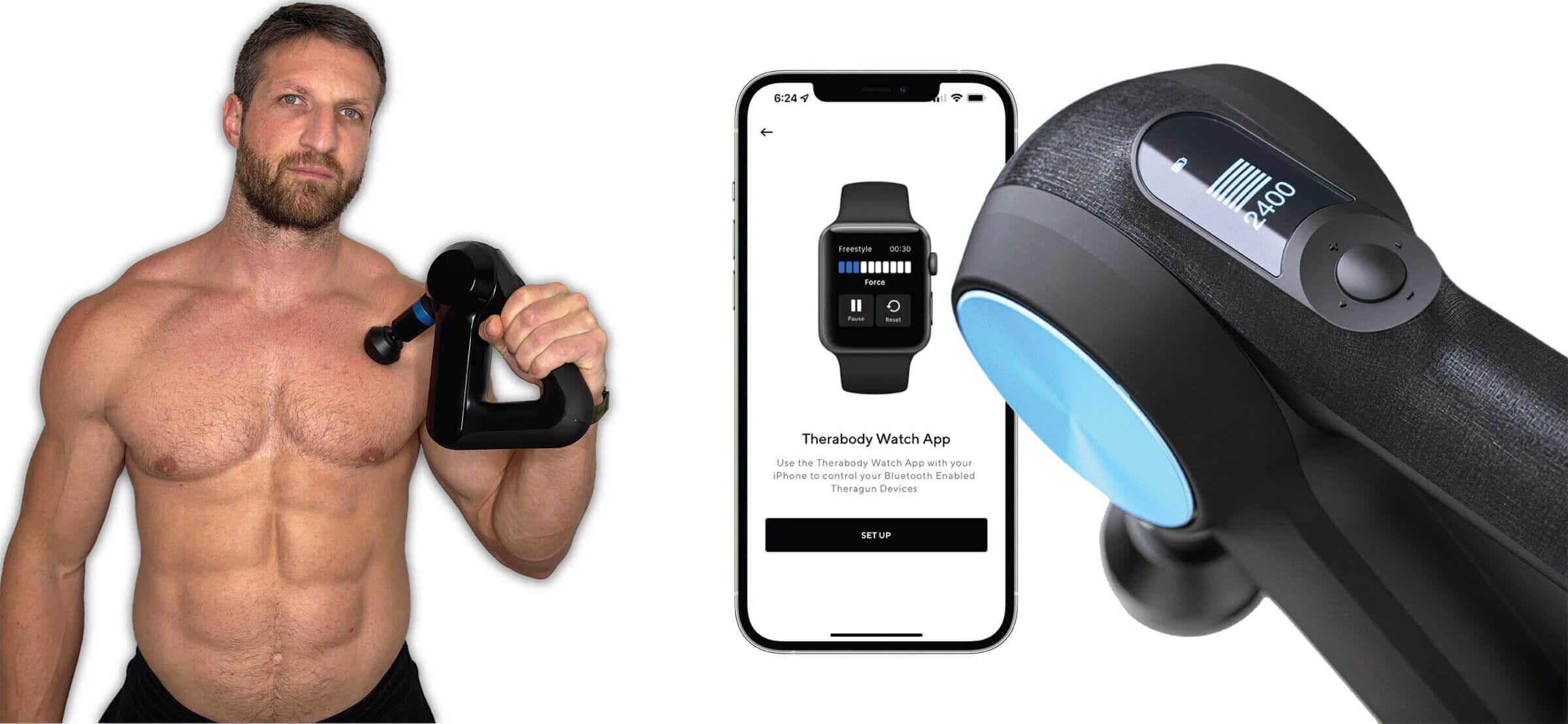Editor’s note: For this review, Michael tested the Theragun Elite, which has been discontinued. However, most of the information in this article applies to Theragun’s products in general. Among the brand’s new product line, the closest replacement for the Theragun Elite is the Theragun Prime Plus. If you have any questions about the new models, don’t hesitate to leave a comment below.
The Theragun Elite is a powerful percussion massage device that has helped both me and my wife relieve painful muscle tension, stop muscle spasms and recover quicker after strenuous workouts.
After having used another percussion massage therapy gun (the Exogun DreamPro) for over a year, we switched to Therabody’s Theragun Elite a couple of months ago.
In this review, I’ll share my impressions of the device and give you an idea of how the Theragun Elite compares to its siblings (the Theragun PRO and Theragun Prime), as well as some of the other popular brands on the market (including Hypervolt).
Theragun Elite
Summary
The Theragun Elite is an effective percussion massage therapy gun with excellent ergonomics, a powerful yet quiet motor and great battery life. It’s the best massage gun I’ve ever owned.
Before we get into the details, let’s talk about the basics!
What Is Percussion Therapy?
Percussion therapy — also sometimes referred to as vibration therapy — is a massage method that aims to improve muscle function and recovery times by deeply pressing into the muscle tissue with a series of rapid, concentrated pulsating strokes.
The basic concept behind percussion therapy is the same as that of a traditional tissue massage. The goal of either form of therapy is to:
- Increase blood flow.
- Reduce soreness.
- Alleviate muscle pain.
- Release tension in muscle tissue.
- Increase range of motion.
If you’ve ever seen construction workers tearing up pavement with a jackhammer, you get the idea. Obviously, a massage device like Theragun is non-invasive and won’t inflict permanent damage.
How Does the Theragun Work?
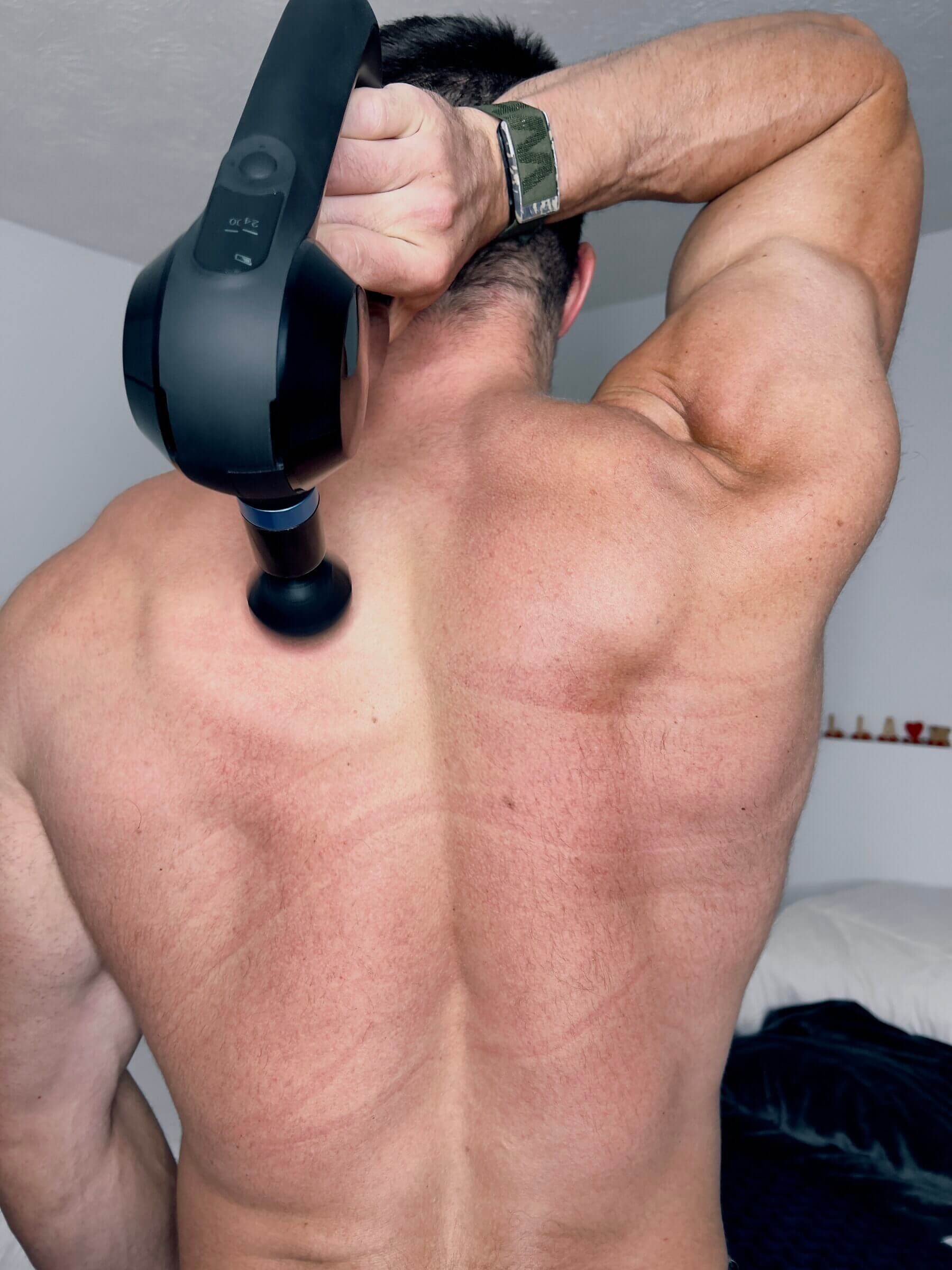
While most massage guns on the market, including the Exogun, resemble a firearm (like an Uzi), the Theragun Elite has a grip in the shape of a triangle for improved ergonomics.
Inside the device, there’s a quiet yet powerful motor that delivers 40 pounds of no-stall force and between 1,750 and 2,400 percussions (or strokes) per minute.
Combined with one of the five included attachments, you can use the Theragun Elite to massage any muscle group, tissue or joint in your body.
The Theragun percussion massager even comes with a cone attachment to work smaller and more sensitive muscles, such as the ones close to your spine.
To get started, all you have to do is turn on the device, select one of the five available speed settings, and start massaging your sore muscle groups.
Besides the vibration speed range, you can influence the intensity of the therapy by applying more or less pressure.
My Hands-On Theragun Review
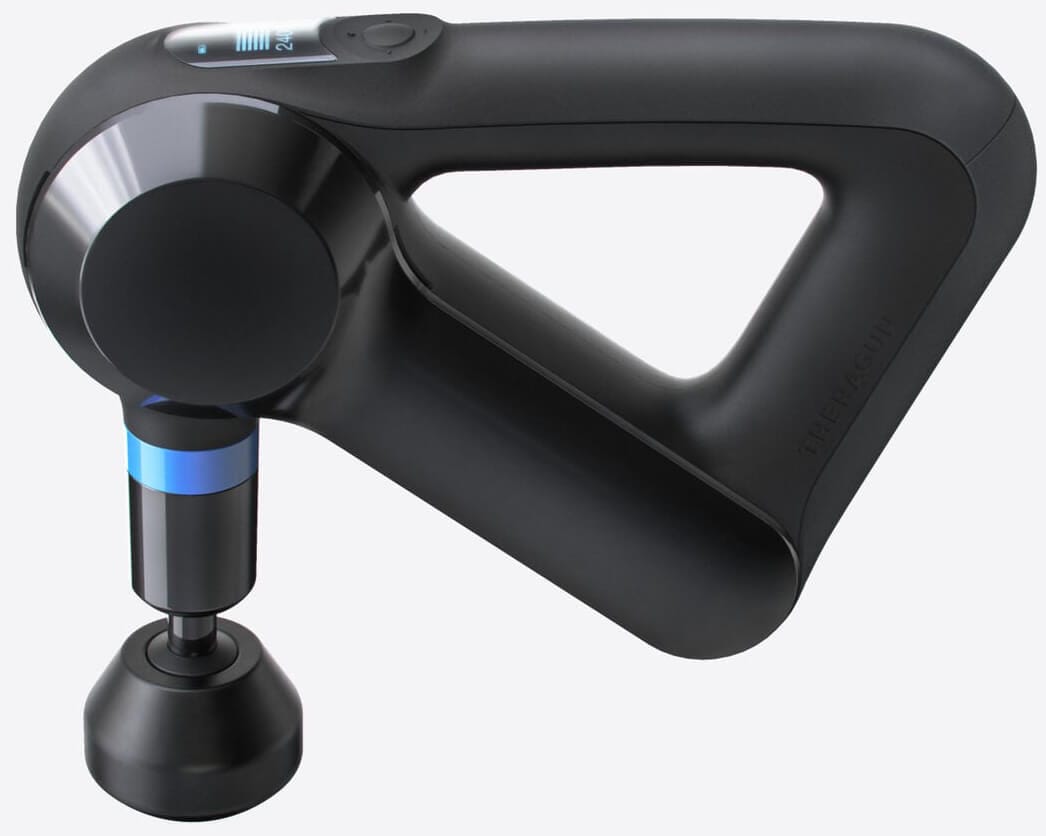
The Theragun Elite is an excellent and easy-to-use percussion massage therapy device with outstanding ergonomics, thanks to a triangular grip that makes it easy to massage even the most difficult-to-reach parts of your body.
For example, both my wife and I periodically suffer from tight muscles right between our shoulder blades; if you do CrossFit or lift heavy weights above your head, you probably know which muscles I’m referring to.
Pros
- Excellent ergonomics.
- Outstanding build quality.
- Powerful.
- Easy to operate.
Cons
- Battery life could be slightly better.
- Glossy plastic shows fingerprints.
- Maximum no-stall force is limited to 40 pounds.
With pistol-shaped massage guns like the Exogun, it’s almost impossible to hit those small muscle groups next to your spine without the help of another person. With Theragun, I can easily massage the muscles on my back (or anywhere else, for that matter) without having to ask for help.
But even for easy-to-reach muscles like my quads or pecks, the triangle-shaped grip allows me to apply pressure without my hand getting tired. When using the Exogun, my grip and wrists would get tired after only a few minutes.
Theragun Elite Accessories and Attachments
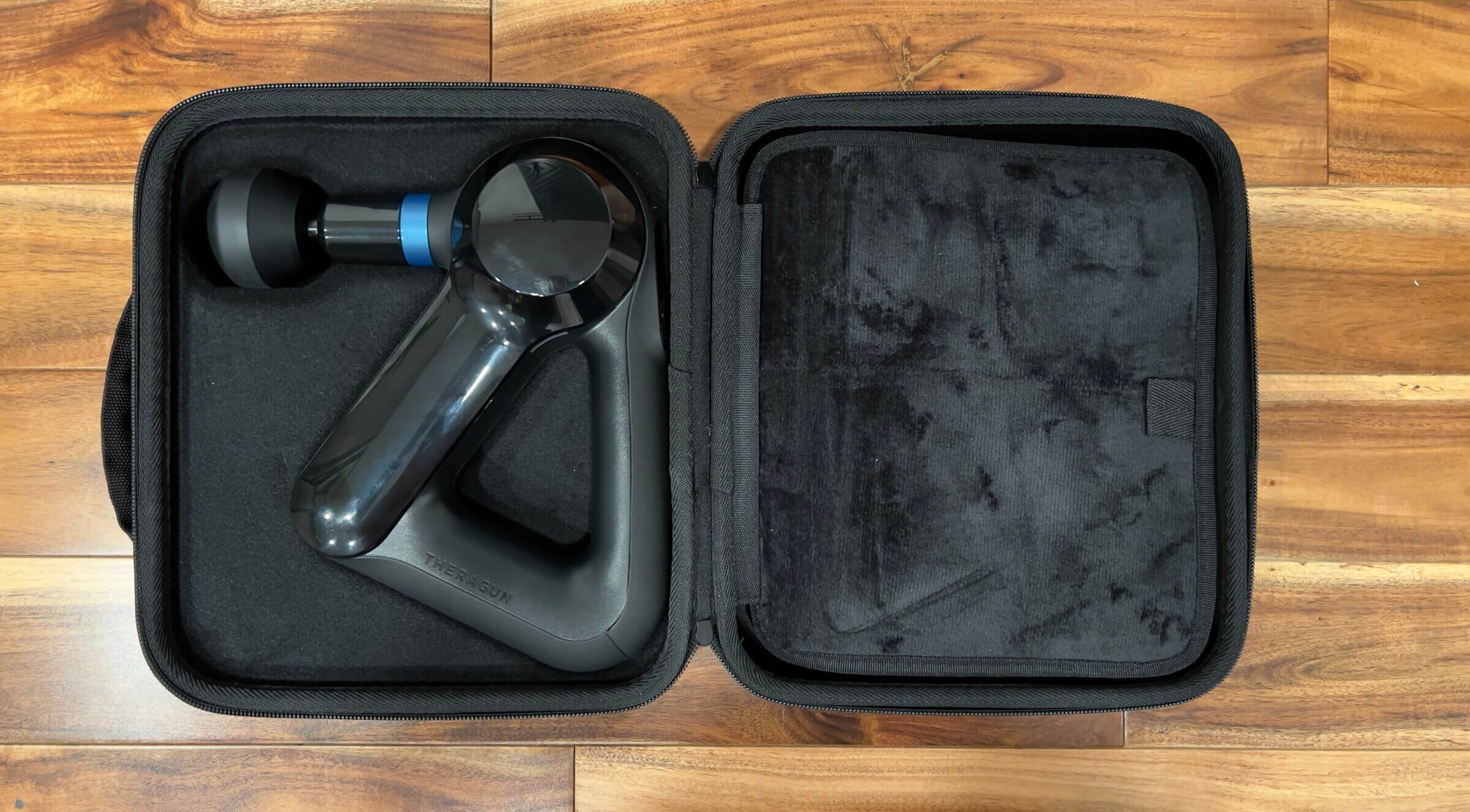
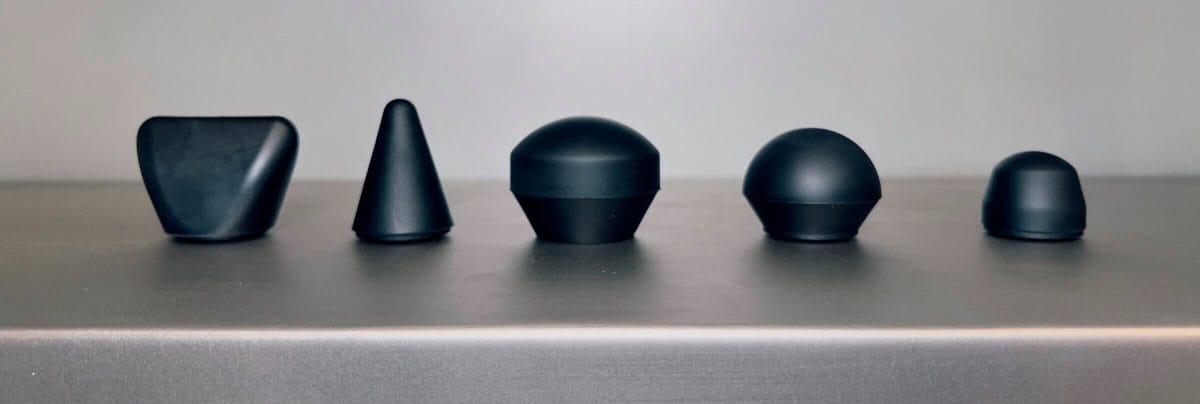
The review unit I received came with five attachments, a charger, and a protective carrying case.
While each attachment (or head) serves a specific purpose, my wife and I have been mostly using the “standard ball,” which is a ball-shaped head attachment meant for larger muscle groups.
The massage heads that come with the device include:
- Standard Ball: It’s the most commonly used attachment and was designed to treat both large and small muscle groups.
- Thumb: Best used on trigger points, knots and the lower back. This attachment is great to really focus on one particular spot on the body (areas of the shoulders or different ligament attachment points, for instance).
- Dampener: This is a great multipurpose attachment. Because it’s softer than the standard ball, it won’t hurt quite as much if you accidentally run over bones while massaging.
- Wedge: The wedge is a perfect attachment to massage the areas around your shoulder blades and your IT bands because you can use it for “scraping” and “flushing” and help increase blood flow and reduce tension.
- Cone: Best used for treating small muscles in your hands and feet.
It’s worth noting that all of the Theragun Elite’s attachments are made with non-porous closed-cell foam that you can easily clean with a disinfecting wipe or wet towel.

The other thing I really appreciate is the quick-release mechanism that makes it easy to swap attachments. If you’re into power tools, you might be familiar with this mechanism from your impact wrench.
Storing and carrying your Theragun, the charger and all accessories is easy, thanks to the high-quality case included with the device.
I had gotten used to the flimsy carrying case that came with the Exogun, so I was surprised by the sturdiness of Theragun’s. It’s not heavy, but it feels like it would protect the device if you accidentally dropped it. The inside of the case has a divider and two compartments to store all of the accessories.
Theragun Technical Specifications
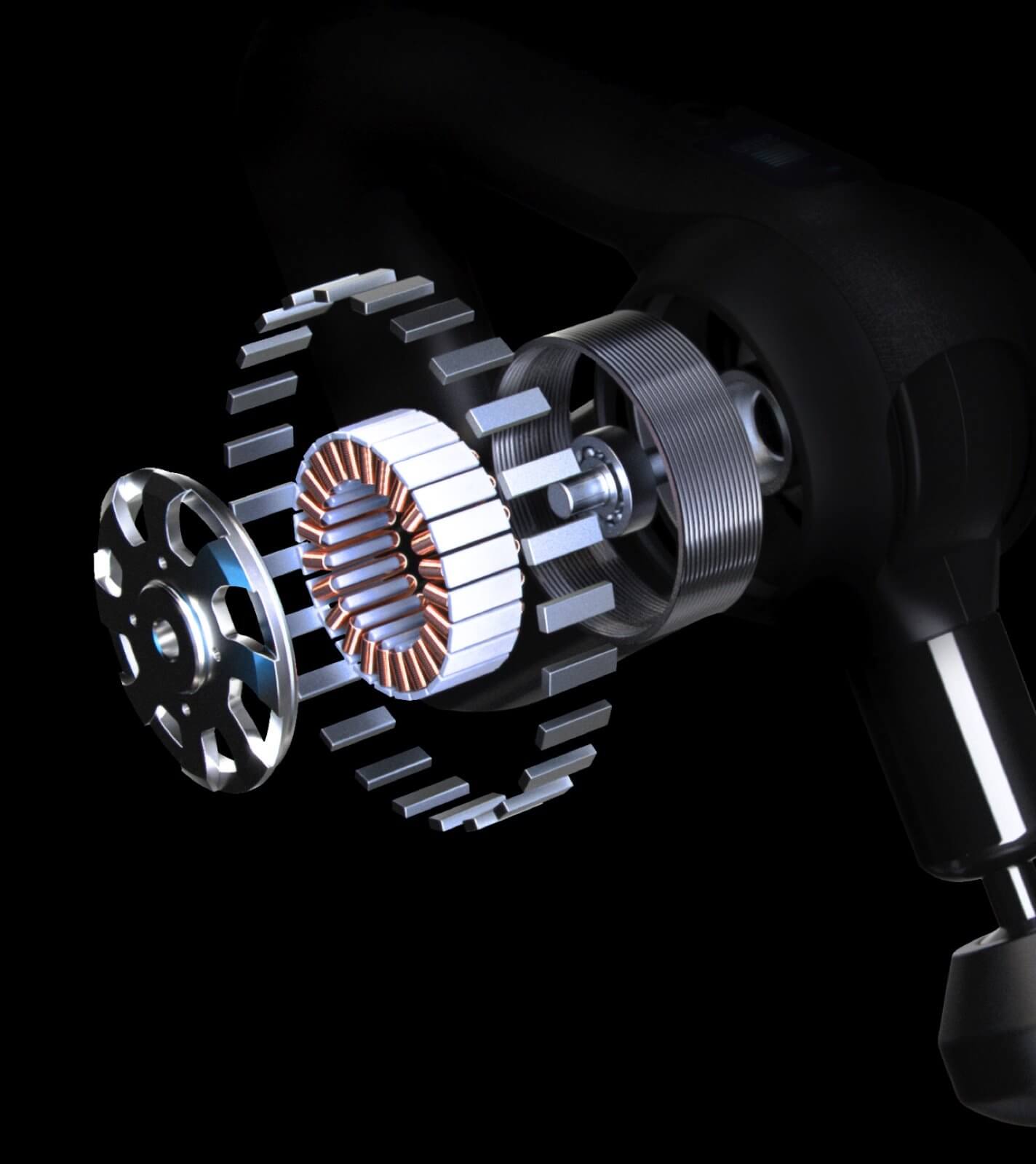
When shopping for and comparing percussion massage devices, there are certain technical specifications you should take into account, including:
- Speed (or percussions per minute).
- Stroke length (or amplitude).
- Max force (or stall force).
- Battery life.
Some vendors describe the speed of their devices in percussions per second (PPS) or hertz (Hz). Others give you the number of percussions per minute. Theragun offers five speed settings with a range of ~29 to 40 percussions per second or 1,750 to 2,400 percussions per minute (PPM).
If you do the math, you’ll realize that 29 X 60 seconds = ~1,750, and 40 X 60 seconds = 2,400.
Here’s a table that shows the exact frequencies of the brushless high-torque motor in each speed setting, in case you’re interested:
| PPM | Hz |
|---|---|
| 1,750 | 29.17 |
| 1,900 | 31.67 |
| 2,100 | 35 |
| 2,200 | 36.67 |
| 2,400 | 40 |
Personally, I think having five different speed settings is plenty. I’d even be OK having fewer options.
What’s worth noting is that some of the competing products offer speeds higher than 2,400 PPM. However, Therabody claims that these higher speeds may be counterproductive because they can desensitize the skin (a result of how the brain acclimates to the stimulation). As is so often the case, more is not always better. And in the case of percussion therapy, less might actually be better.
Stroke Length

The Theragun Elite’s stroke length is 16 mm or 0.63 inches. That’s how far the attachment head travels back and forth, and it’s pretty standard based on what I’ve seen from other devices. A sufficient stroke length is key for deep muscle treatment and when treating larger muscle groups, such as the glutes, hamstrings or quads.
However, there are percussive massage devices out there that offer less amplitude than 16 mm, or which don’t share the specifics (as is the case with Hypervolt).
Maximum Force
The maximum force (or “stall force”) of the motor that’s built into the Theragun Elite is 40 pounds. That means the motor will turn off if you apply more than 40 pounds of pressure.
Depending on your threshold for pain, 40 pounds is plenty of pressure to get the desired therapeutic results — especially when compared to the amount of pressure massage therapists can create using their hands.
However, there might be certain cases involving larger muscle groups where more pressure would be beneficial (especially if you have a high pain threshold).
My glutes and quads are the two strongest muscle groups in my body, and I have a relatively high pain threshold. As a result, I tend to be fairly aggressive with the pressure I apply when using Theragun on these areas. Despite that, I’ve never stalled out the device during normal operations.

If you feel like you need even more pressure than the Theragun Elite can deliver, you can always opt for the Theragun PRO, which offers 60 pounds of maximum force.
Both the Theragun Elite and Theragun PRO have a force meter built into their display so that you can see if you’re getting close to the device’s maximum force threshold.
Battery Life and Charging Time
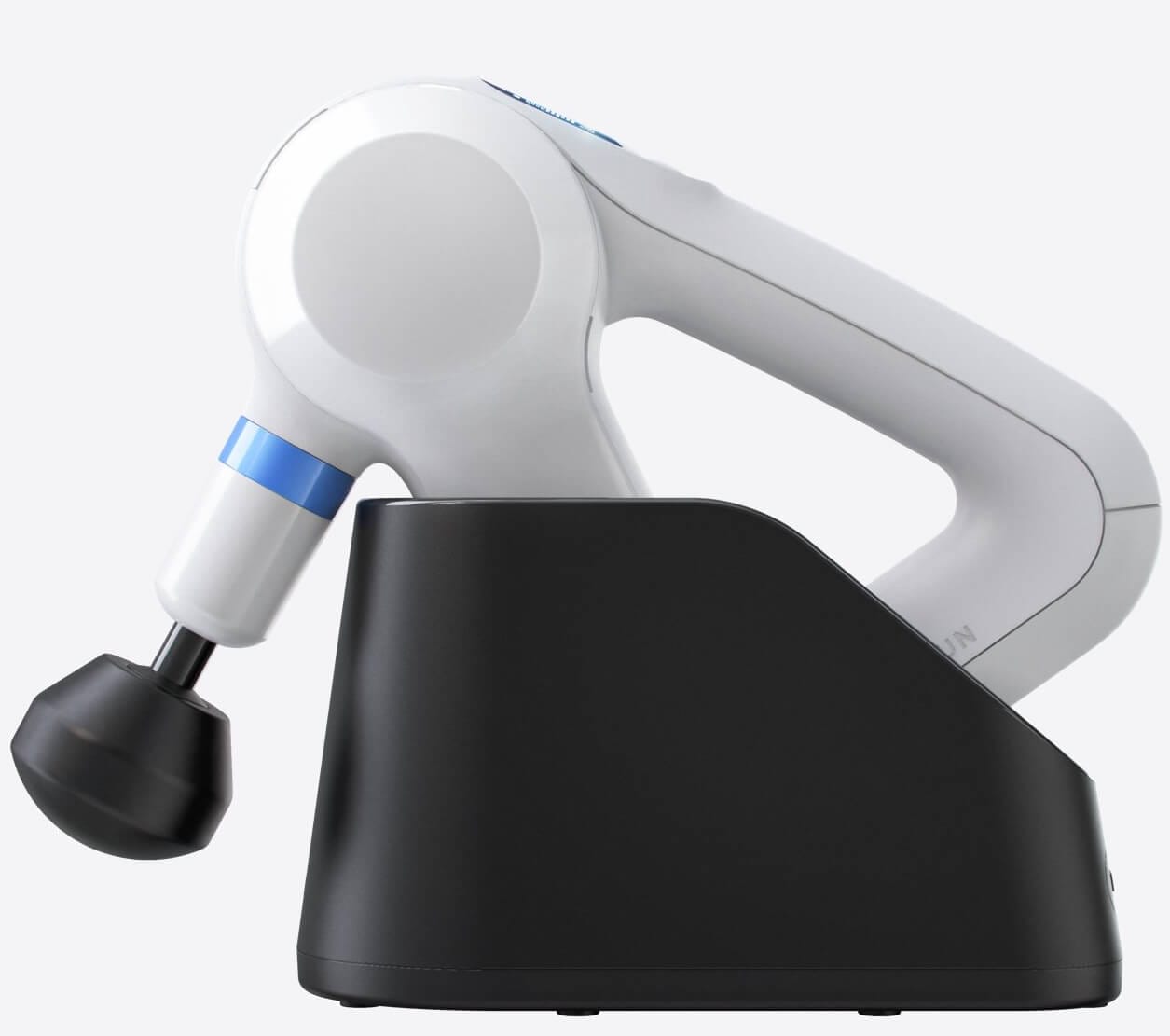
According to Therabody (the company that makes Theragun), the device lasts up to 120 minutes on a full charge, depending on the speed setting and the amount of pressure you apply. I assume you’ll only get the full two hours out of a charge when using the device on the lowest speed setting, but I haven’t done exact measurements yet.
While Therabody includes a regular charger in the box, you can get a wireless charging stand for $79. The advantage of the wireless charging stand is that it looks neater and it makes it a bit easier to charge the gun, because you don’t have to mess with cables.
My wife and I dislike the sight of cables cluttering up our desks and counters, so we’re seriously considering getting the charging stand.
Charging the battery from 0% to 100% takes approximately 110 minutes using either the charging cable or the wireless charging stand.
What I Would Improve

No product is perfect, and there’s always room for improvement. If I was in charge of product design, I’d replace the glossy side panels with matte versions because the glossy design collects fingerprints and is more prone to scratching.
I’d also like to see improved battery life, which I’m sure everyone who doesn’t have the convenient wireless charging stand would appreciate.
If you own the charging stand and you dock the gun after every use, you’ll be perfectly fine; after all, I doubt you’ll massage yourself for longer than two hours at a time.
I don’t have the wireless charging stand and I don’t like loose cables, so I end up just throwing my Theragun into our “recovery basket,” which also holds our PowerDot, a scraper tool and some other stuff we frequently use after intense workouts. As a result, it doesn’t get charged until it’s out of juice — and sometimes that means it’s not available when I want to use it.
The charging stand alleviates that problem because it provides a tidy storage solution that ensures the device is always ready to go.
Pricing (Is the Theragun Elite Worth It?)
Theragun Elite is one of the best percussion massage therapy guns on the market, and both its build quality and pricing reflect that.
The Theragun Elite costs $399 and is wedged between the more basic Theragun Prime ($299) and the commercial-grade Theragun PRO ($599).
While that’s certainly a good chunk of money, I think the Theragun Elite is worth the price tag if you’re a serious fitness enthusiast (like I am) or even a professional athlete.
It’s also worth the investment if you suffer from chronic muscle pain due to injury or an accident, and if you use it instead of or in combination with going to a massage therapist.
For example, the average price of a deep tissue massage is somewhere between $90 and $110. If you do the math, the Theragun Elite would only cost you as much as four massages. But considering that you can expect to get several years out of your Theragun, you can save a lot of money with this percussive therapy device.
Theragun Mobile App
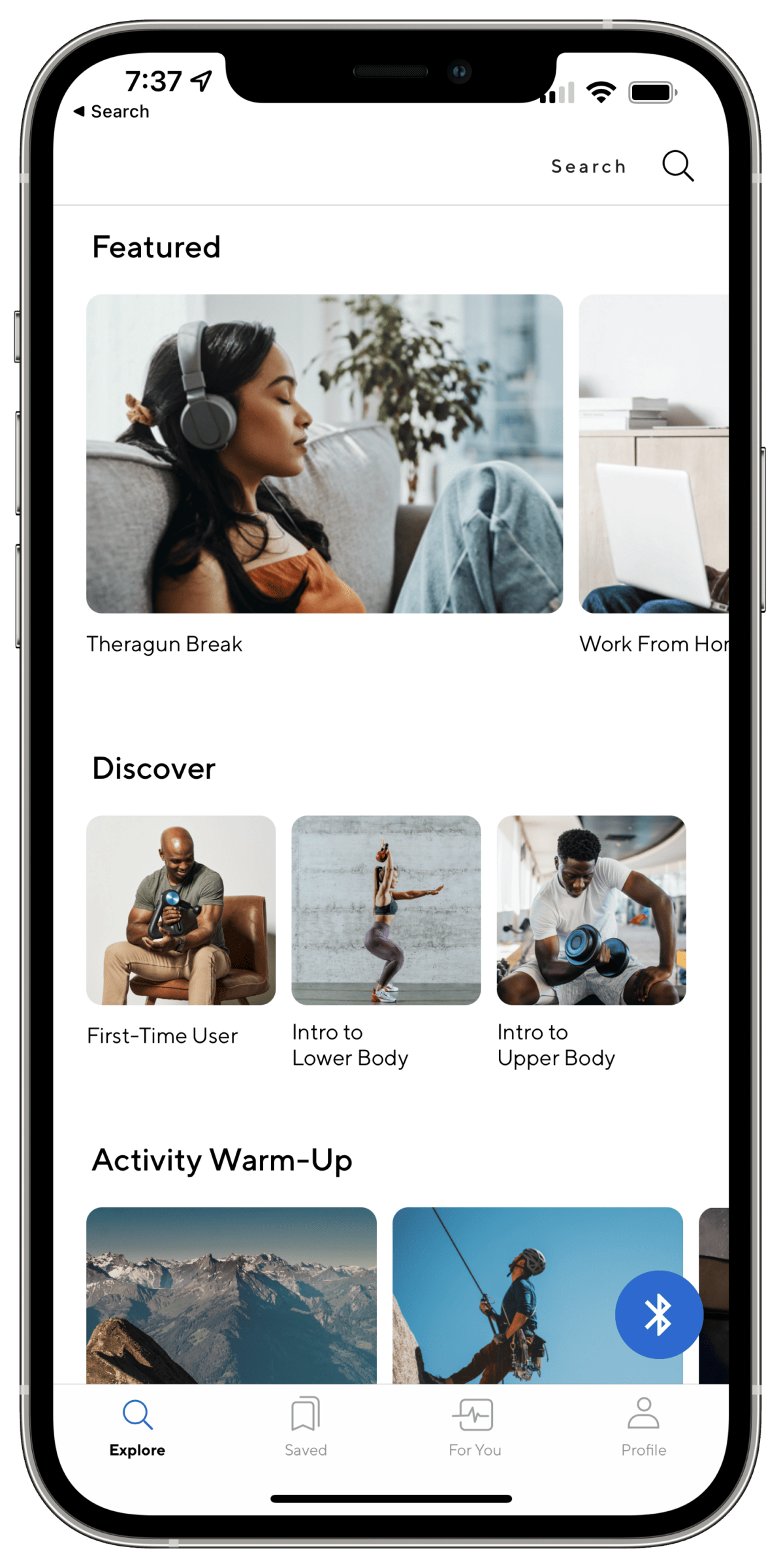
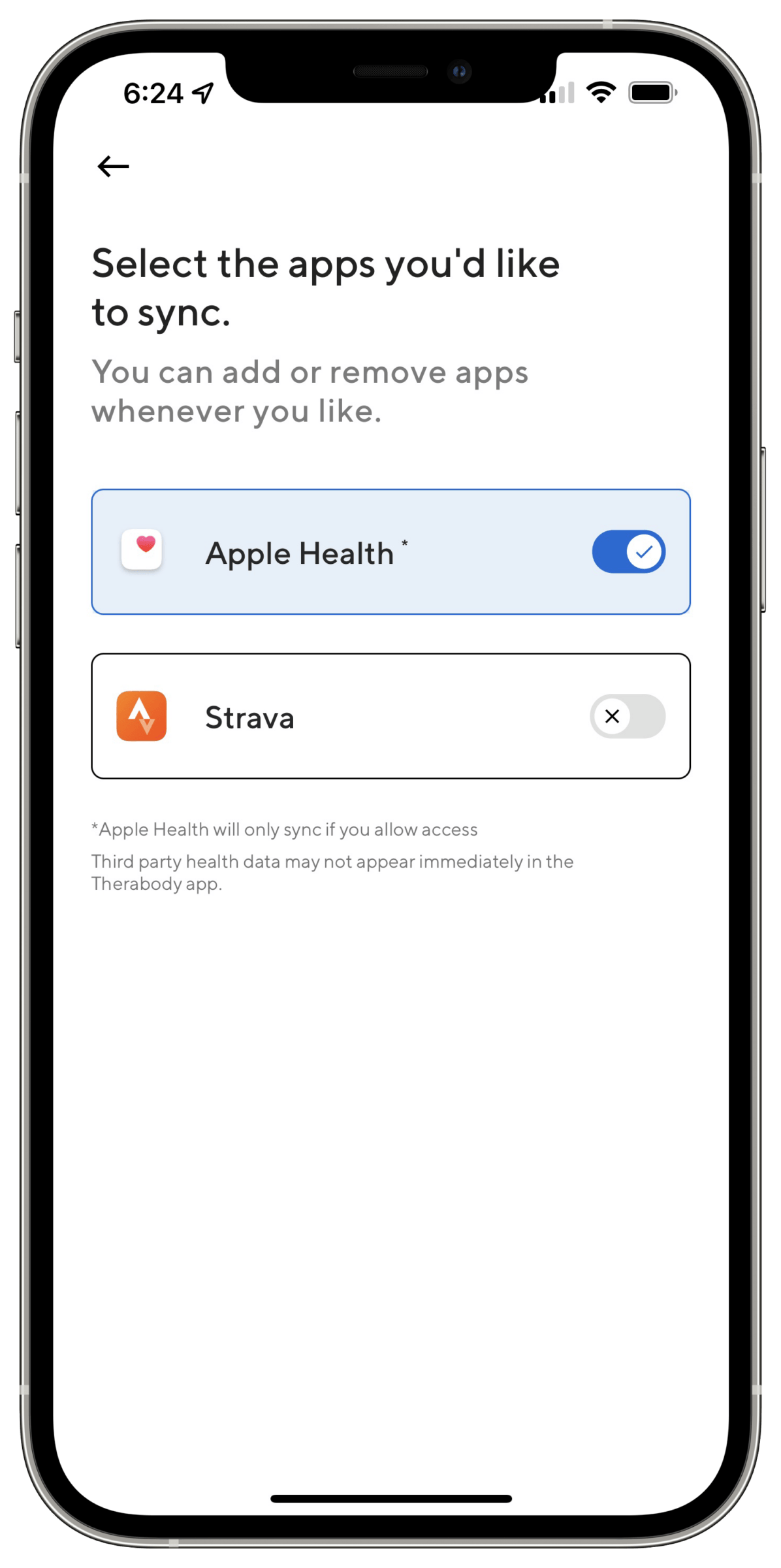
What I didn’t realize at first was that the Theragun has a built-in Bluetooth radio that you can use to change the device’s settings via a companion mobile app. The Theragun app can even integrate with Apple’s HealthKit and Strava to automatically recommend recovery programs after strenuous workouts.
Additionally, you can choose from an extensive catalog of wellness, warm-up, recovery and body part-specific programs that automatically configure Theragun’s settings (such as speed).
I’ll show you some examples of what that means in the next two sections.
The Therabody app is available for iOS and Android. After registering for an account and confirming your email address, just turn on your Theragun to pair it with your phone via Bluetooth. Once complete, you can answer a few questions (e.g., what type of workouts you perform on a regular basis) to help the app to get to know you better and recommend customized programs.
How to Use Theragun for Warmup and Activation
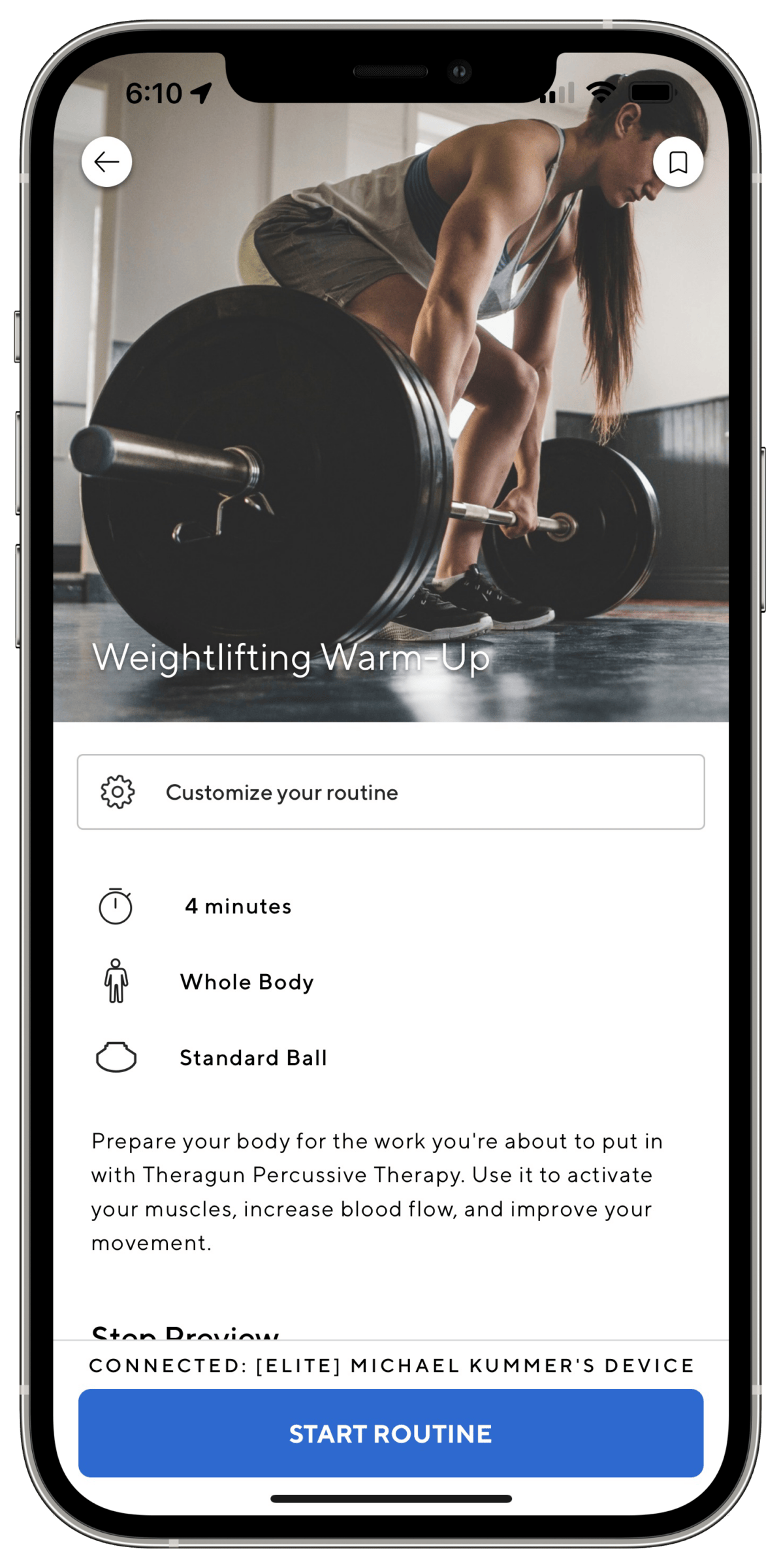
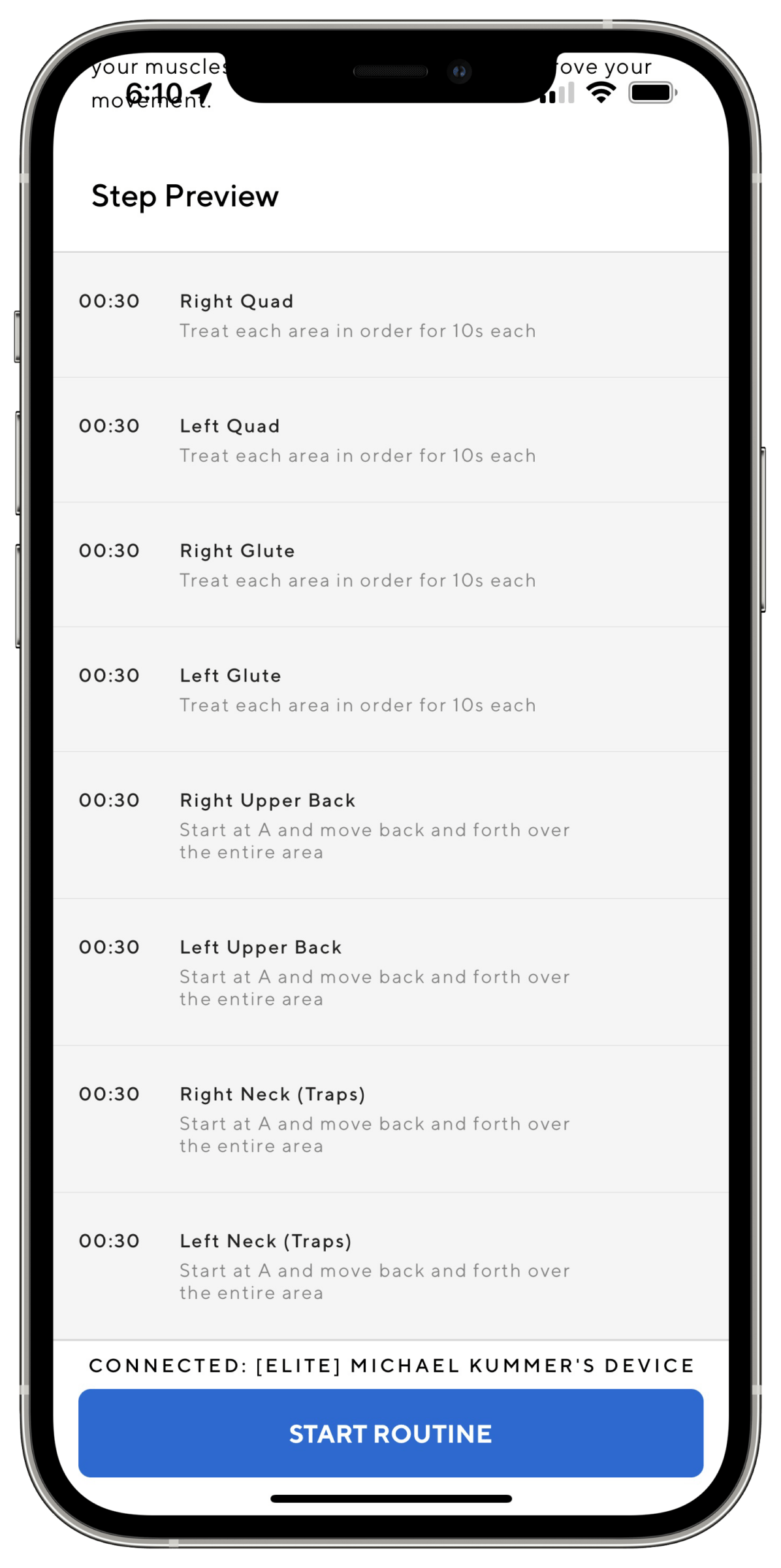
Using Theragun for warmup and activation is a straightforward process. All you have to do is “float” Theragun over the muscles you want to warm up for 30 seconds each.
After you’ve had Theragun for a while, you’ll get to know which attachment to use and what percussion speed works best for a given muscle. But when you’re new to the device and/or new to percussion massage therapy in general — or if you want to discover new ways to warm up for an upcoming workout — I recommend checking out Therabody’s mobile app.
For example, if you want to warm up your body for a weightlifting session, you can find the corresponding program in the app’s catalog.
As you can see in the screenshots above, the program recommends what muscle groups you should warm up and what attachment you should use. The app also tells you how long the warmup routine is going to take.
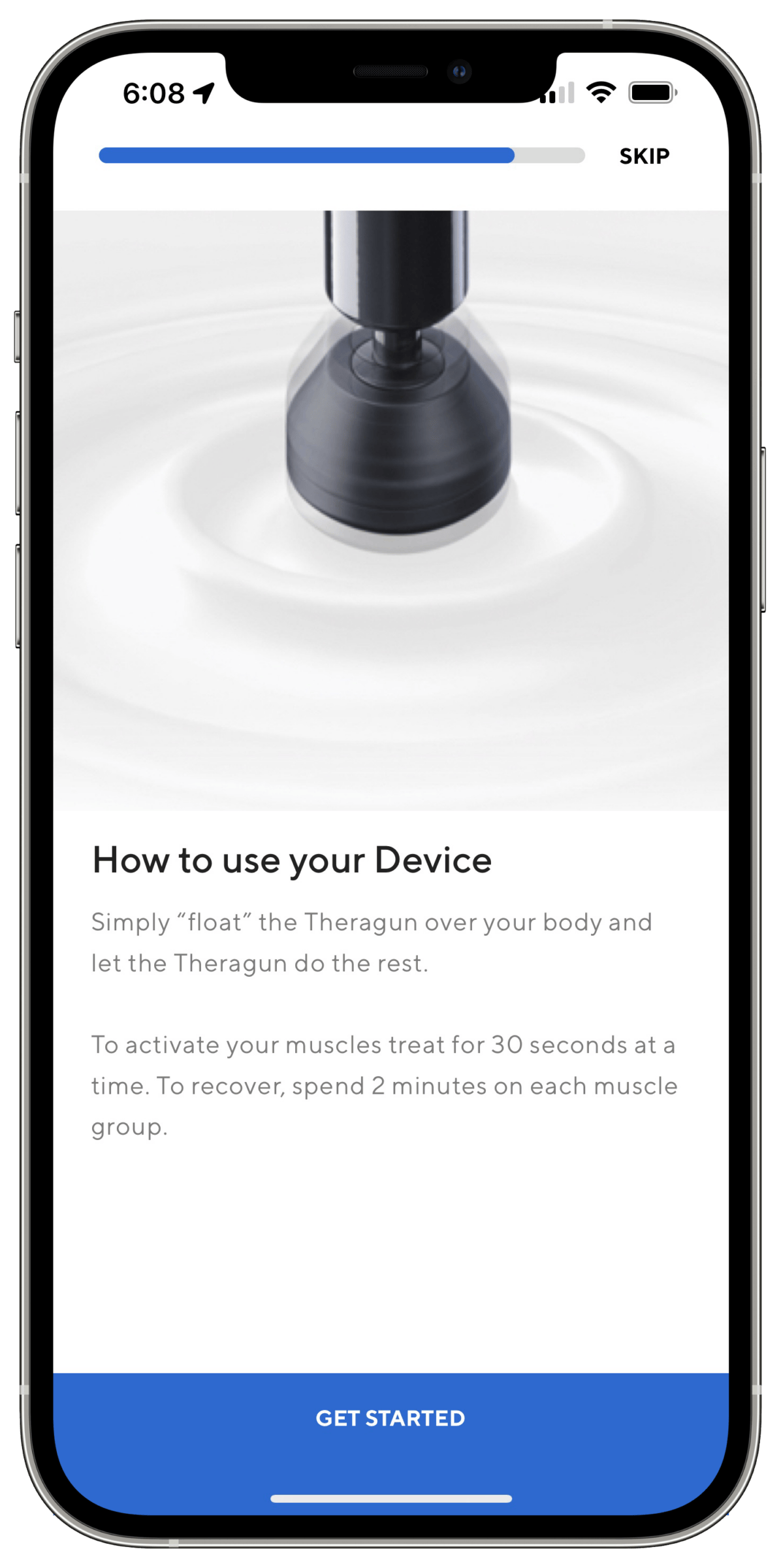
Additionally, the app guides you through the entire sequence and lets you know when to switch from one area to the next.
I’ve noticed that by using Theragun before CrossFit workouts, I have to spend less time and expend less energy on traditional warmup routines and I’m “ready to go” much quicker.
How to Use Theragun for Recovery
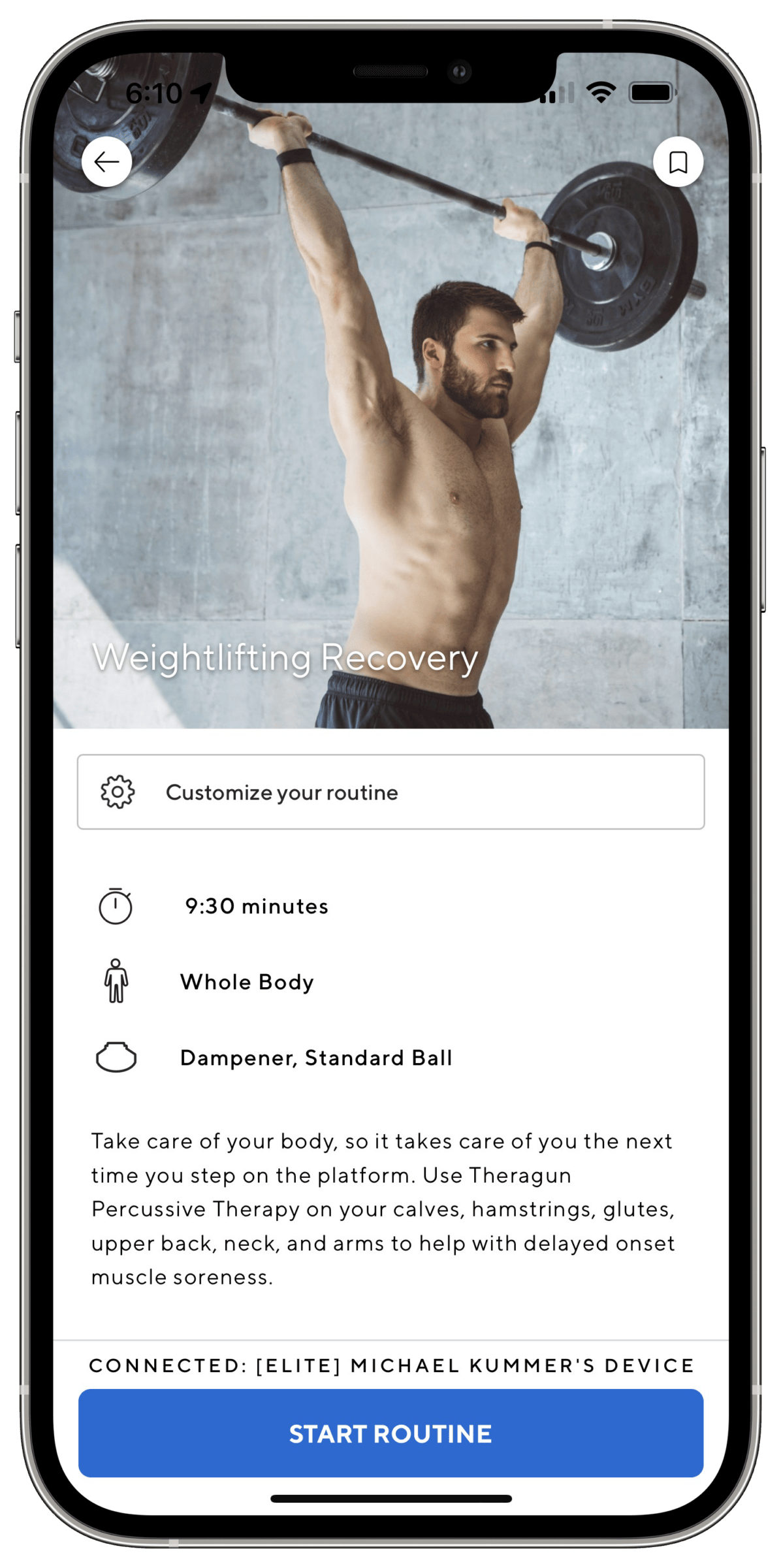
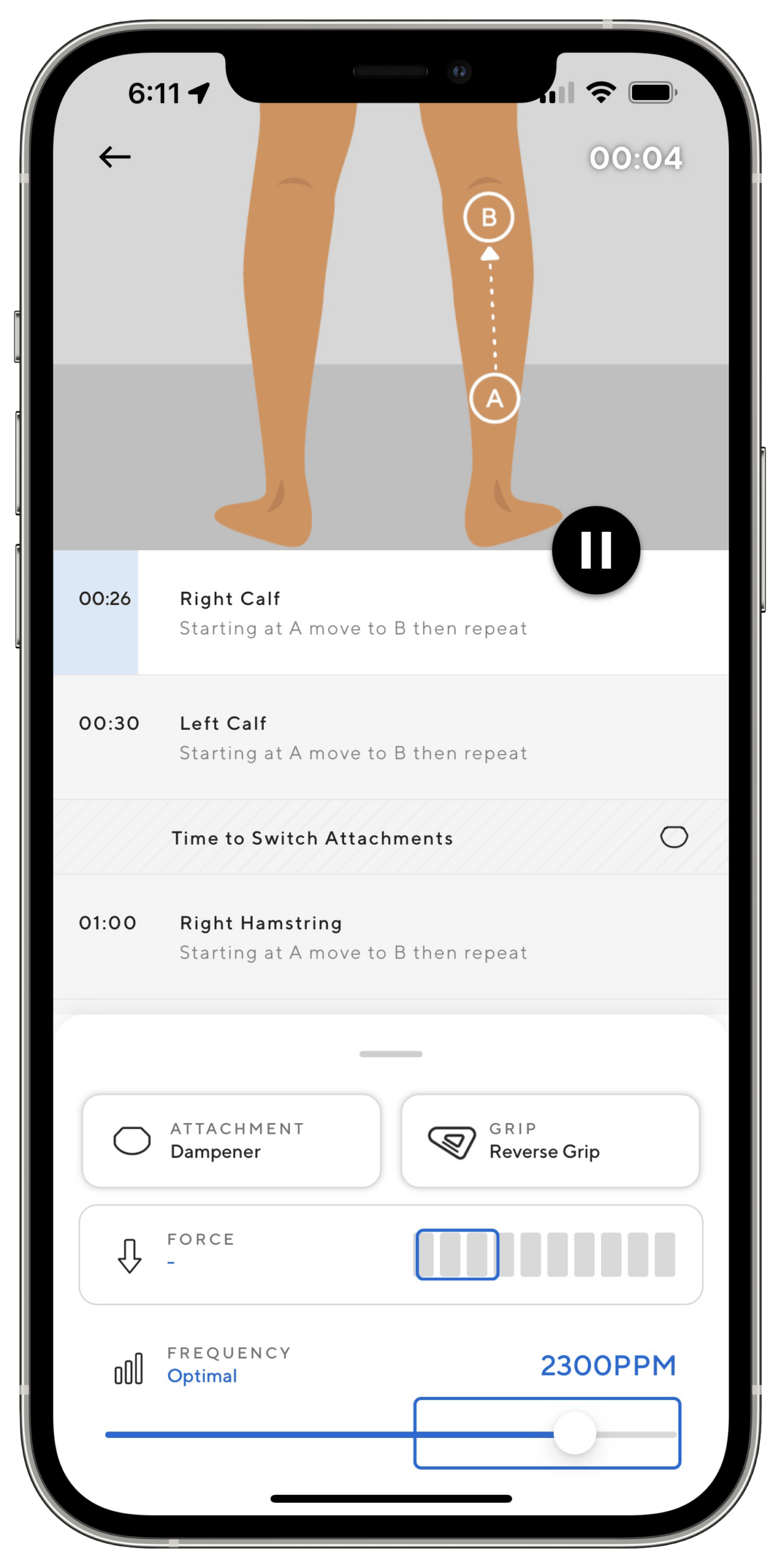
Using Theragun for recovery is similar to using it for activating your muscles. However, instead of 30 seconds, you should spend about two minutes on each muscle. The idea is to elicit sufficient oxygenated blood flow to reduce the delayed onset of muscle soreness.
As with the previous example, the Therabody app is a great resource to guide you through the process. The app even tells you how to grip Theragun for the best ergonomics, and how much pressure you should apply for maximum effectiveness.
So even if you’ve used percussion massage guns in the past, I recommend letting the app guide you for a few sessions so you get a better idea of how much pressure is necessary to achieve the desired results.
Theragun Devices: Side-by-Side Comparison

While I’ll cover the differences between the Theragun Elite and Theragun PRO in more detail in the next segments, here’s a top-level comparison of all the Theragun models, including the Theragun Prime and mini.
| PRO | Elite | Prime | mini | |
|---|---|---|---|---|
| Motor | QX150 professional grade motor with QuietForce technology | QX65 proprietary brushless motor with QuietForce technology | QX65 proprietary brushless motor with QuietForce technology | QX35 proprietary brushless motor with QuietForce technology |
| Max no-stall force | 60 lbs | 40 lbs | 30 lbs | 20 lbs |
| Noise | High | Low | Lowest | Lowest |
| Active torque control | ✔ | ✔ | ✔ | ✔ |
| OLED screen | ✔ | ✔ | ✘ | ✘ |
| Bluetooth | ✔ | ✔ | ✔ | ✘ |
| Built-in presets | ✔ | ✔ | ✘ | ✘ |
| Mobile app | ✔ | ✔ | ✔ | ✘ |
| Amplitude | 16 mm | 16 mm | 16 mm | 12 mm |
| Speed range | 1,750 – 2,400 | 1,750 – 2,400 | 1,750 – 2,400 | 1,750 – 2,400 |
| Adjustable arm | ✔ | ✘ | ✘ | ✘ |
| Battery life | 300 min | 120 min | 120 min | 150 min |
| Wireless charging | ✔ | ✔ | ✘ | ✘ |
| Attachments | 6 | 5 | 4 | 1 |
| Weight | 2.8 lbs (1.3 kg) | 2.2 lbs (1.0 kg) | 2.2 lbs (1.0 kg) | 1.4 lbs (0.65 kg) |
| Warranty | 2-year limited warranty | 1-year limited warranty | 1-year limited warranty | 1-year limited warranty |
| Price | $599 | $399 | $299 | $199 |
Theragun PRO vs. Elite vs. Prime
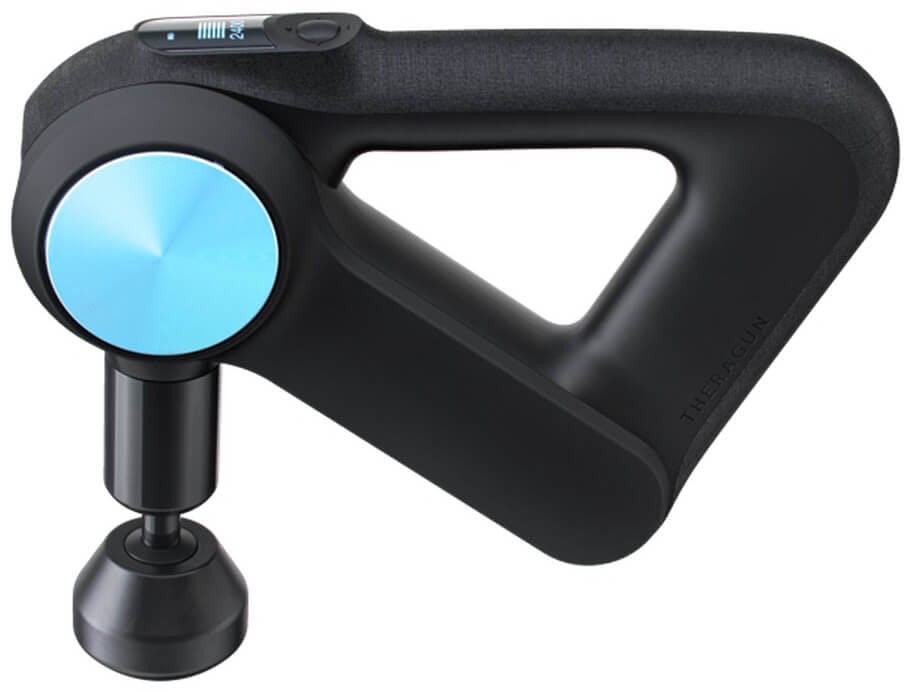
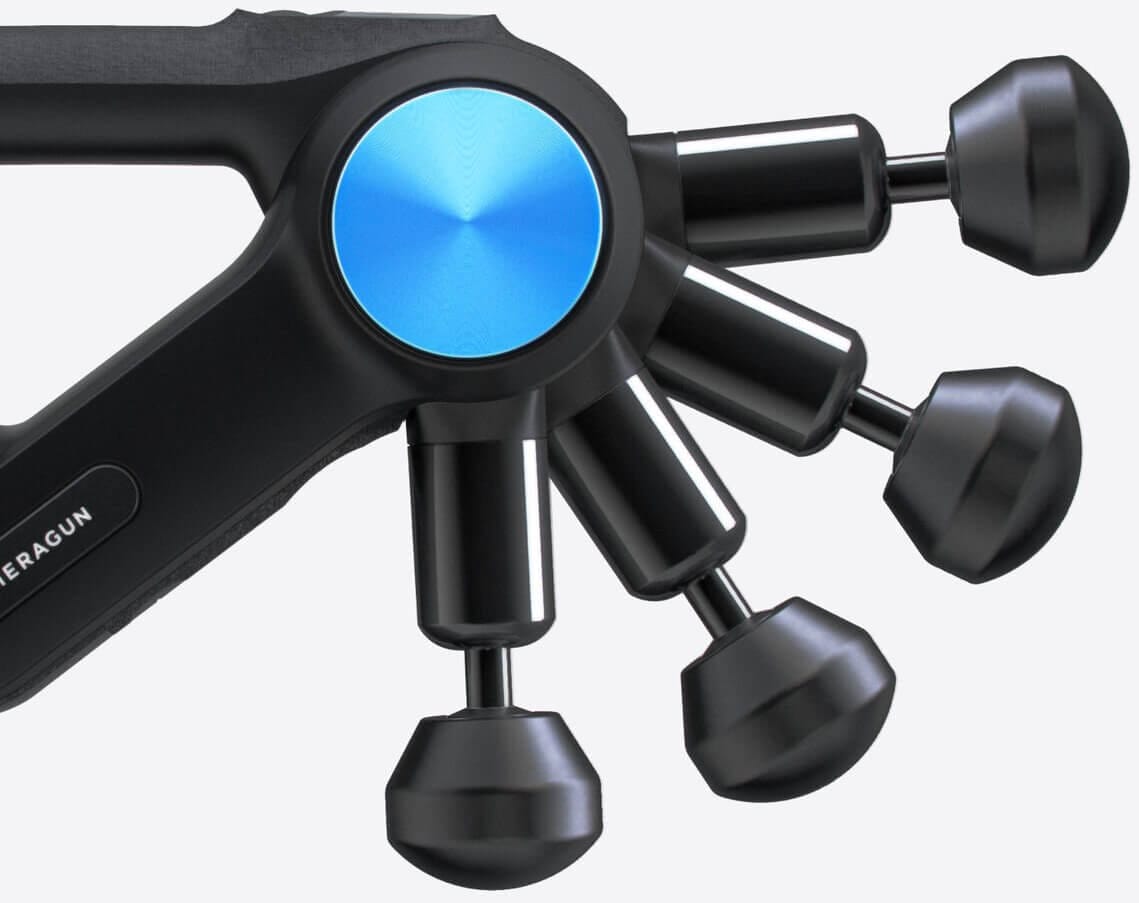
While the Theragun Prime, Theragun Elite and Theragun PRO are quite similar, there are a number of distinct differences between these devices.
The Theragun PRO is Therabody’s commercial-grade massage gun. It offers the most powerful motor and maximum no-stall force (60 pounds). Unfortunately, the QX150 professional-grade motor is also the loudest.
Besides those differences, the performance specs of the Theragun PRO are pretty much in line with the Elite and Prime. In other words, you can get an excellent deep tissue massage out of all three devices.
From a usability perspective, it’s worth noting that the Theragun PRO offers a rotating arm to reduce hand and wrist strain. Additionally, Theragun PRO comes with two external lithium-ion batteries that provide a whopping 300 minutes of total usage. That means you can charge one battery while using the massage gun and then just swap it out.
That’s a great feature for physical therapists or chiropractors to reduce the number of devices they need when treating multiple patients back-to-back.
As far as the number of attachments are concerned, the Theragun PRO comes with six because it includes the Supersoft attachment (which you won’t get with the Theragun Elite or Prime).
While I’m quite satisfied with the performance of my Theragun Elite and I appreciate how quiet it is, I wouldn’t mind having the swappable battery packs. That way, I could always have one battery charged and never risk having a dead battery because we forgot to plug in the device.
Theragun Mini vs. Theragun PRO, Elite and Prime
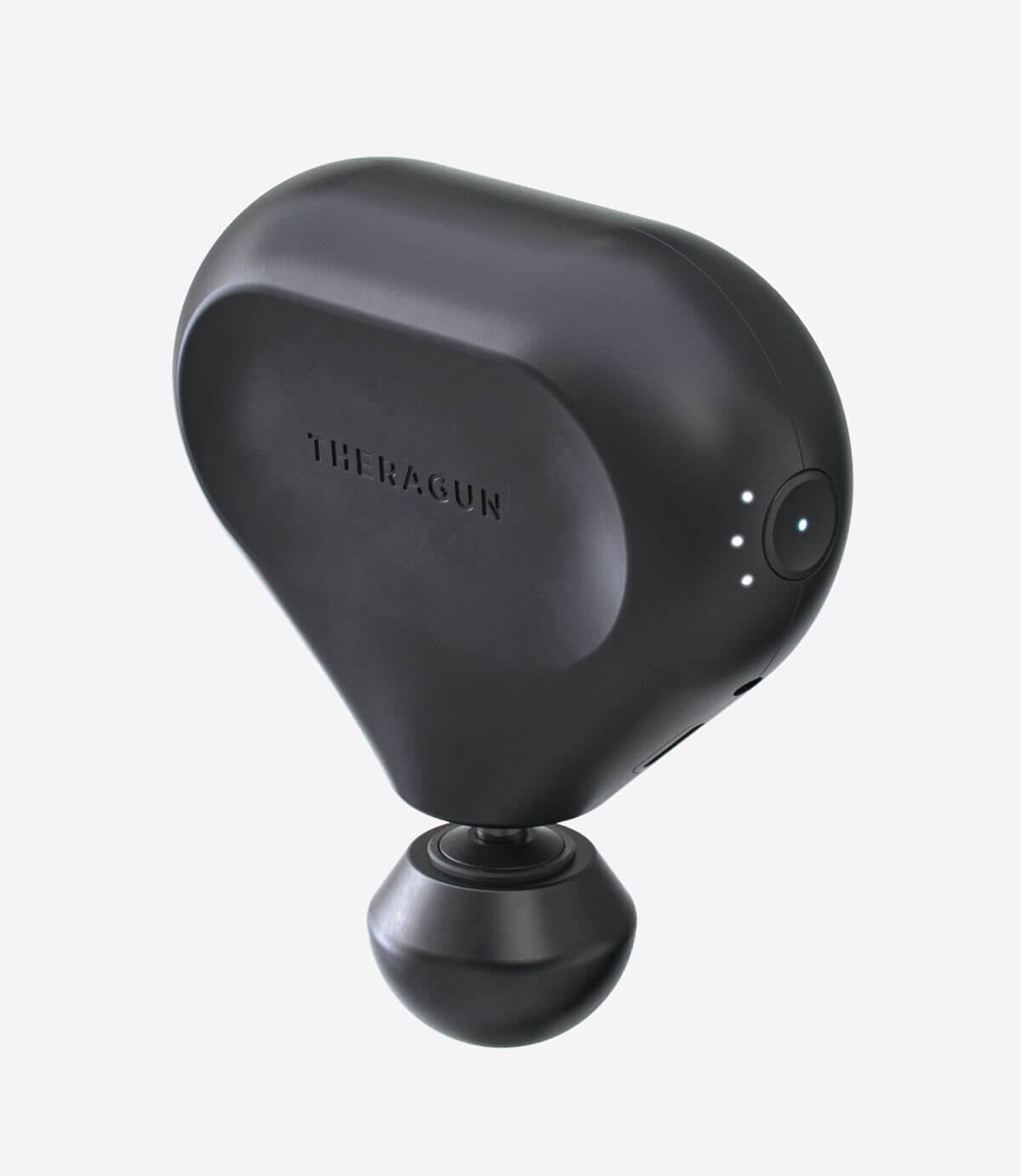
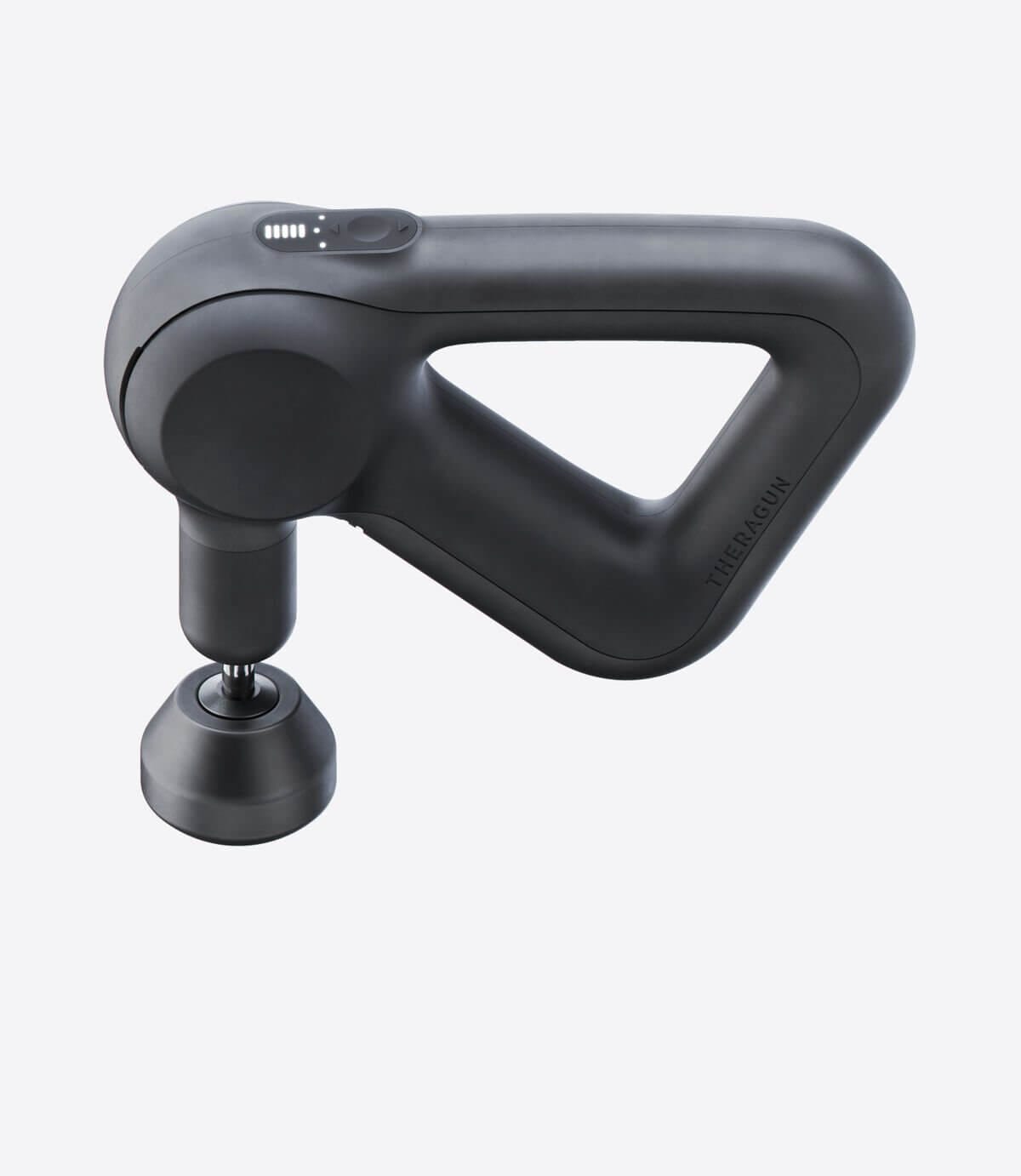
The Theragun mini is quite different from the brand’s other three percussive therapy devices, as you can tell by its form factor and weight. In a nutshell, the Theragun mini is meant to provide portable, on-the-go relief instead of assuming the role of your primary percussion massage device.
The mini’s small profile means you can easily throw it into your gym or travel bag. While I don’t own the Theragun mini and have no hands-on experience with it, I bet it makes a great travel companion; just imagine getting a quick deep tissue massage after a long flight or car ride. I surely wouldn’t mind that!
The downsides of the Theragun mini include its relatively low maximum no-stall force of 20 pounds and the reduced amplitude of 12 millimeters.
Additionally, the Theragun mini comes with only one attachment (you can purchase more if you like), and it doesn’t have any smart capabilities (such as app integration and Bluetooth connectivity). Plus, it has only three built-in speed levels instead of five.
Theragun Elite vs. Theragun G3
The current Theragun Elite is a fourth-generation device that offers a few important improvements over the previous generation (G3), including:
- 75% quieter motor.
- Double the battery life.
Theragun PRO vs. Theragun G3Pro
Similar to the Theragun Elite, the latest-generation Theragun PRO offers the following improvements over its previous generation (G3Pro), including:
- 55% quieter motor.
- Double the battery life.
Additionally, the 4th generation Theragun devices also feature an updated design with blue accents, a Bluetooth radio for the mobile app integration and an OLED screen that displays the current battery life, RPM setting and a force meter.
Theragun Elite vs. Hypervolt
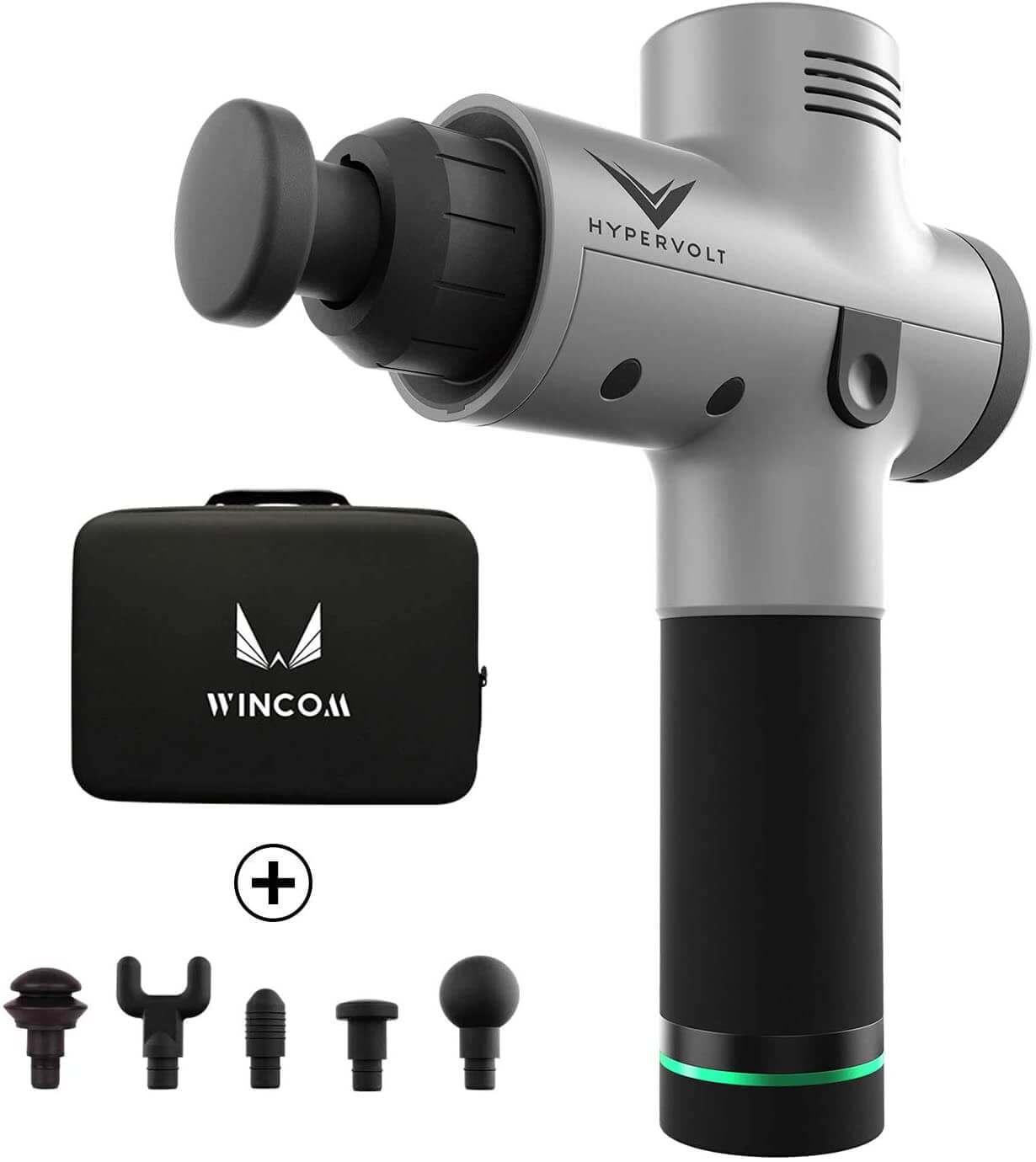
Hypervolt is another popular percussive massager (available in two models) that I’ve seen some athletes use.
While I don’t have any hands-on experience with the device, here’s a quick comparison table based on its specifications and a chat with the company’s customer support:
| Theragun Elite | Hypervolt | Hypervolt Plus | |
|---|---|---|---|
| Speeds | 5 | 3 | 3 |
| Percussions per minute | Up to 2,400 | Up to 3,200 | Up to 3,200 |
| Ergonomics | Excellent | Poor | Poor |
| Adjustable arm | ✘ | ✘ | ✘ |
| Swappable battery | ✘ | ✘ | ✘ |
| Battery life | 120 min | 180 min | 180 min |
| Multi-grip | ✘ | ✘ | ✘ |
| Travel case | ✓ | Not included | Not included |
| Amplitude | 16 mm | N/A | N/A |
| Max force | 40 lbs. | N/A | N/A |
| Attachments | 5 | 5 | 5 |
| Weight | 2.2 lbs. | 2.5 lbs. | 2.5 lbs. |
| Cost | $399 | $349 | $399 |
Unfortunately, Hyperice (the company that makes the Hypervolt) isn’t incredibly forthcoming with some of the device’s key specifications. For example, the company doesn’t share the amplitude or stall force, two major factors in percussion therapy.
Speed and Percussions per Minute
Hypervolt offers three distinct speed settings, delivering 2,000, 2,600 and 3,200 RPMs. In comparison, the Theragun Elite offers a customizable speed range (five speed settings) ranging from 1,750 to 2,400.
You can certainly debate whether more speed settings or a higher speed is better. I don’t have a strong opinion on the matter, but I think higher speed settings desensitize the skin faster than lower settings, thus potentially reducing the effectiveness of the percussion massage.
Ergonomics
One of the most important things I’ve learned while testing different percussion massage devices is that the popular pistol grip isn’t very ergonomic and causes your hands and wrists to fatigue quickly.
Additionally, the pistol grip makes it almost impossible to apply enough pressure when massaging hard-to-reach muscles, such as the ones on your back.
As a result, I would no longer recommend getting a massage gun with a pistol grip.
Battery Life
Hypervolt’s battery is listed as lasting up to three hours, but according to the company’s own FAQ, you can expect about two hours on average.
That’s pretty much in line with Theragun’s battery life.
Amplitude and Stall Force
When I pressed the company to release the stall force, they responded with: “Ok so we don’t measure stall forces because the motors are made to withstand any force.”
What a load of crap! That’s physically impossible.
When I pushed further, I got the following (more reasonable but still unsatisfactory) response:
We currently do not have that measurement available. Here at Hyperice, we measure the power of our products with the combination of factors that we found were optimal for use on the human body, including percussions per minute (up to 3200), battery life (3.5 hours) and our brushless 60-watt motor.
Our engineers and product team has undergone a lot of testing and our Hypervolt does not stall under use on the human body, and we have found the pounds of pressure is comparable with others on the market. If you have any other product questions, we would be happy to answer them!
I’ll try to get my hands on one of these devices to see if I can gauge the real stall force and amplitude. For now, I wouldn’t buy from a company that is incapable of releasing such basic information.
Price
Hypervolt is available for $349 directly from hyperice.com or for $359.99 on Amazon. The Plus version is $50 more expensive but includes a 90-watt motor instead of the 60-watt motor that comes in the standard device.
Note that if you buy Hypervolt on Amazon, you also get a travel case!
Theragun Elite vs. Exogun
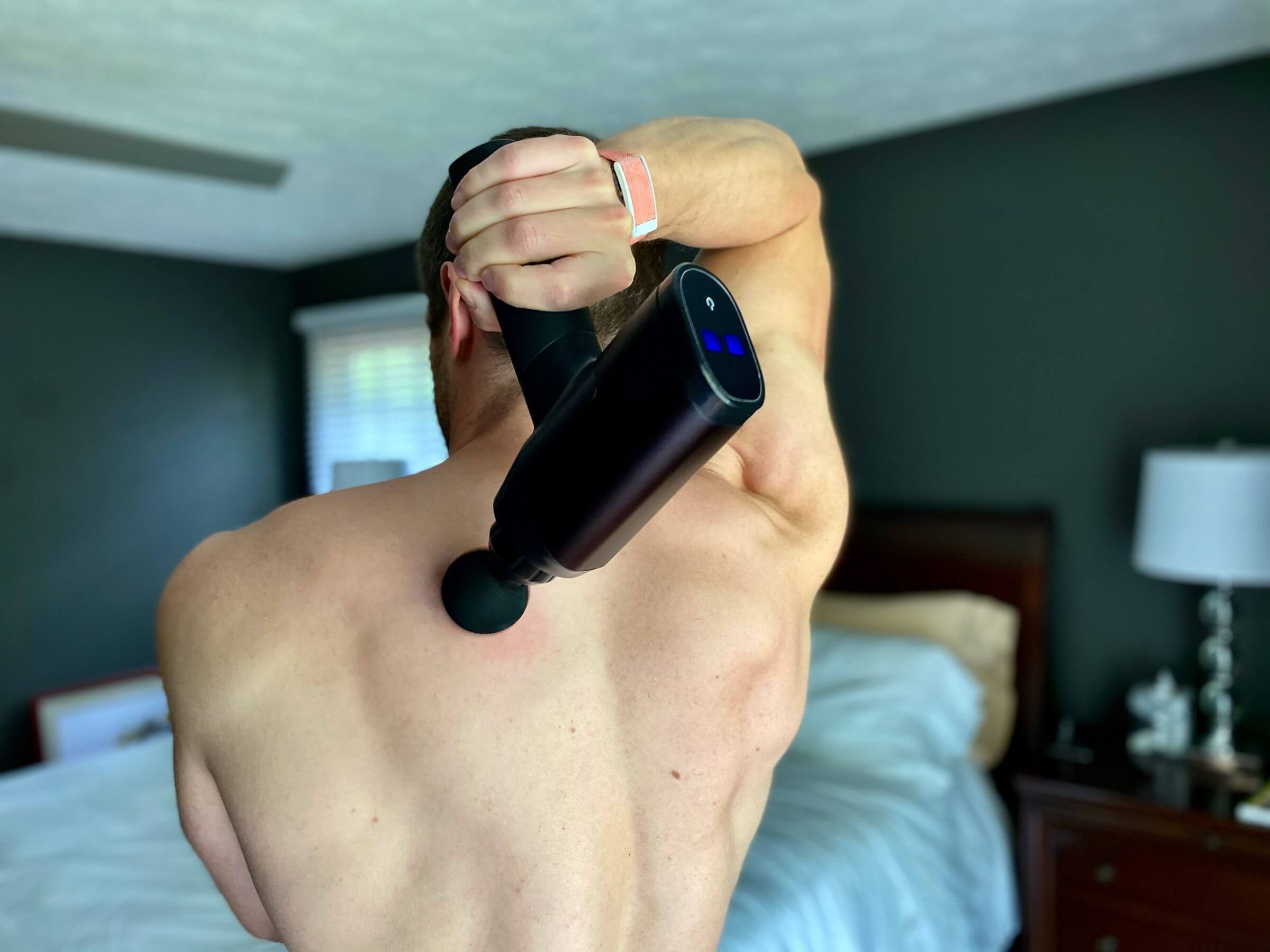
Before getting the Theragun Elite we used the Exogun DreamPro for over a year. While we never had any issues with the device, I heard about hardware problems and bad customer support from several of my readers. As a result, I no longer recommend Exogun despite its attractive pricing.
| Exogun | Theragun Elite | |
|---|---|---|
| Speeds | 6 | 5 |
| Percussions per minute | Up to 3,200 | Up to 2,400 |
| Ergonomics | Poor | Excellent |
| Adjustable arm | ✘ | ✘ |
| Swappable battery | ✘ | ✘ |
| Battery life | 240 min | 120 min |
| Multi-grip | ✘ | ✓ |
| Travel case | ✓ | ✓ |
| Amplitude | 16 mm | 16 mm |
| Max force | 60 lbs. | 40 lbs. |
| Attachments | 4 | 5 |
| Weight | 2.5 lbs. | 2.2 lbs. |
| Cost | $149 | $399 |
As you can see in the table above, the Exogun has several advantages over the Theragun Elite — at least on paper.
Based on my hands-on experience with both devices, I’d recommend the Theragun over the Exogun for several reasons, including the quality of the materials, the customer support and the ergonomics.
However, as I mentioned above, I’ve heard from several Exogun customers who received a defective unit and then had to argue with customer support to get a replacement or their money back.
I ordered two Exoguns (one I gave to my sister-in-law) and haven’t had any issues with either, but your mileage may vary.
Percussion Therapy vs. Regular Massage
If you’ve been leveraging regular massages for recovery, you might be wondering if percussion therapy is more or less effective than a traditional massage.
From a scientific perspective, both vibration therapy and regular massages are equally effective in the prevention of delayed onset muscle soreness, according to a study from 2014.
| Percussion Therapy | Massage | |
|---|---|---|
| Improves recovery and soreness | ✓ | ✓ |
| Cost | $ | $$$ |
| Involves human touch | ✘ | ✓ |
| Availability | Anytime | Requires planning |
But the effectiveness of each method isn’t the only factor to consider. Getting a massage involves human touch and often a tranquil environment with essential oils and soothing music.
You can replicate the latter while using a percussion gun, but it’s not the same as being touched by another human.
On the bright side, massages are usually expensive and the cost involved quickly exceeds that of the price of a percussion massager.
The other advantage of using a device like the Theragun is that you can use it pretty much any time, without the need to make an appointment and wait for availability.
Of course, this doesn’t need to be an either/or choice. While my wife and I will continue using the Theragun as part of our recovery program, we’ll also continue getting massages from time to time.
When to Use a Percussion Massage Gun

When the first percussion guns came to market, you had to have a good reason to buy one, considering their price tag. As a result, such devices only made sense for certain groups of people (like professional athletes).
Now that you can get a high-quality massage gun for under $400, more people can enjoy their benefits.
So here are some of the use cases I see for cordless massage devices like the Theragun:
- As an alternative to recreational massage therapy or soft tissue massage.
- If you suffer from chronic muscle pain.
- To loosen up your lower back or neck muscles (for example, if you sit a lot).
- As a recovery tool for professional or amateur athletes.
- As a general muscle massager (for example, if you have tired legs at the end of a long day at work).
I started using Theragun before workouts, to get the blood flowing and to get my muscles prepared. I also use it after workouts if I feel sore or if I tweaked something. Additionally, I use my percussion massager at my desk when I feel like my neck could use a low impact massage.
Can Theragun Cause Damage?
The motor in Theragun is pretty powerful and so it’s only reasonable to wonder whether this massage gun can inflict tissue or muscle damage if used inappropriately.
It should go without saying that if you have a broken bone, a strained muscle or a torn ligament, you should exercise caution and not “go to town” on the affected area with a massage gun. If you do, you can certainly cause further damage or slow down the healing process.
So if you’re injured, consult a knowledgeable physical therapist before considering percussion therapy.
Additionally, I recommend consulting a medical professional if you’re on blood thinners or if you’ve been diagnosed with atherosclerosis. If you have issues with blood coagulation and rupture a blood vessel during percussion therapy, you might bruise, and that could lead to complications.
Additionally, there have been cases of ischemic stroke caused by massaging the neck area (but without the use of a massage gun) around the carotid artery. The hypothesis is that massaging large blood vessels that already have arterial plaque can cause the plaque to dislodge and lead to a stroke. I don’t know how common that is, but if you’re concerned about it, you should avoid using the massage gun on the area around your neck.
With all of that said: if you’re healthy, free of injury and simply want to use percussion therapy as an alternative to traditional massages, the risk of inflicting any serious damage is minimal. Massage guns are used by millions of people, and so far, I’ve only seen a handful of case reports that correlate the use of massage guns with health issues.
I should also mention that there are articles on the internet claiming that massage guns can cause ruptured blood vessels, stretched collagen and elastin fiber, damaged muscle fiber, increased nerve sensitivity and other risks. However, I have yet to see any credible evidence to back up these claims, in cases where the massage gun is used appropriately.
Frequently Asked Questions
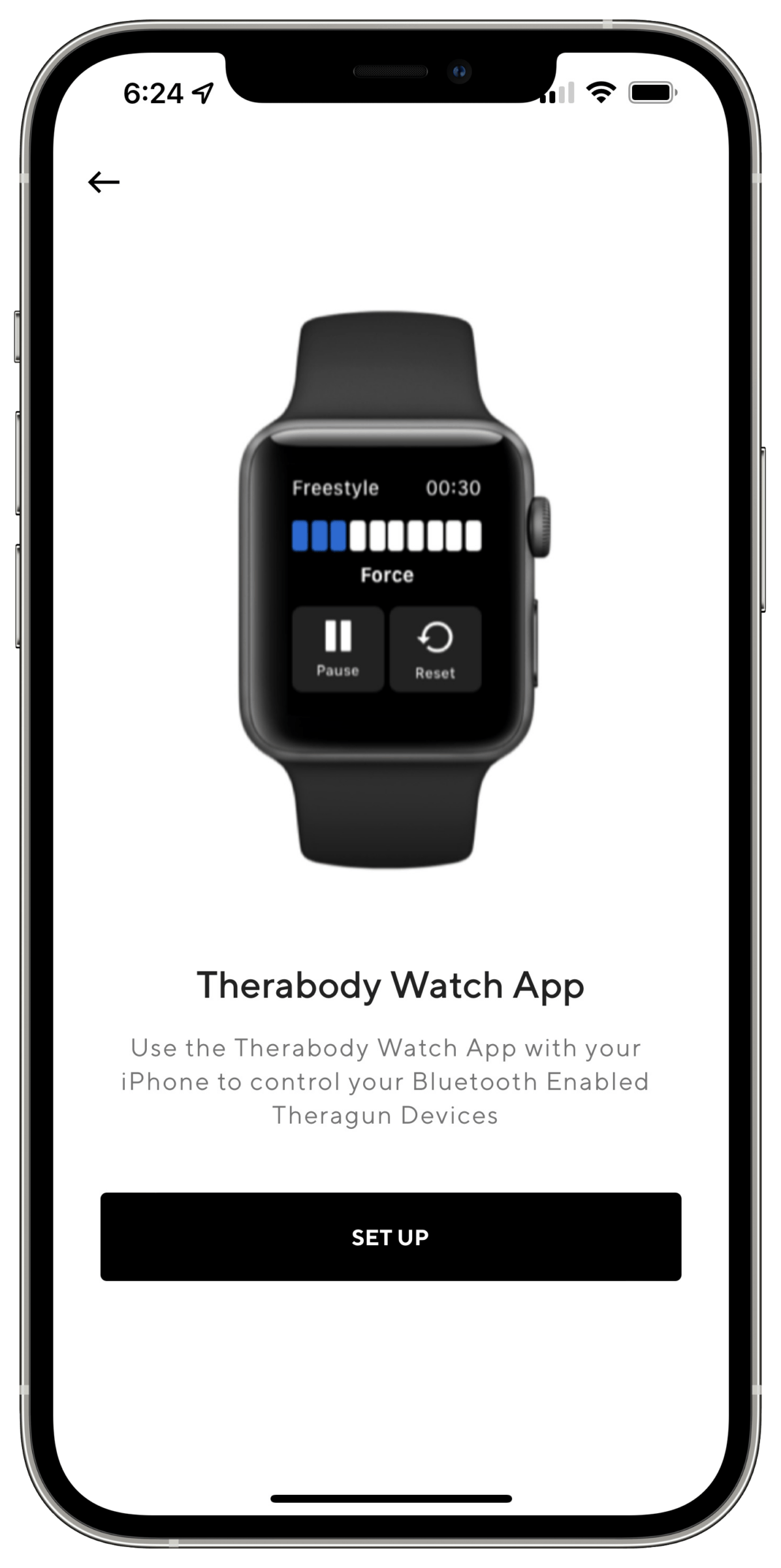
While the battery life of a Theragun ranges from somewhere between 120 to 300 minutes, you can expect to get several years out of your device, depending on how often you use it. If you use your Theragun in a commercial setting, I recommend choosing the Theragun PRO, which offers a two-year warranty.
While I consider weight loss to be the byproduct of a healthy lifestyle, studies have shown that vibration therapy can actually help break down fat cells and get rid of cellulite.
Both Theragun and foam rollers are excellent tools for myofascial release to reduce pain and soreness. The advantage of foam rollers is that you can target large muscle groups using only your bodyweight as pressure, whereas the Theragun is easier and more effective for targeting specific areas because it penetrates muscles deeper and with more intensity.
Our kids have used massage guns on both their own bodies as well as on ours. Some brands recommend their devices for adult use only, but as long as you’re careful, I don’t see why kids over a certain age can’t use it.
I don’t think they need percussion therapy, but I also don’t think it’ll do any harm.
Based on scientific studies, both methods are equally effective in reducing muscle soreness. So it’s ultimately a personal choice of which method to use. From a financial perspective, I prefer percussion therapy, but I enjoy human touch more than using a device.
A brushless motor uses electromagnetic force to operate. That makes it less noisy and more efficient. Some of the cheaper massage guns on the market use brushed motors. As a result, they’re louder and offer less battery life. So I’d recommend staying away from those.
I haven’t seen any third-party attachments that work with Theragun.
As far as I know, battery priming isn’t necessary. Based on what I know about batteries, this strategy was only useful to older battery technologies, such as nickel cadmium (NiCd). Lithium ion batteries have max capacity available from the beginning, and you don’t need to charge them before the first use.
Both percussion therapy and EMS are excellent tools to speed up recovery by increasing blood flow in the affected areas. That’s why I regularly use both my PowerDot (EMS) and Theragun when I’m in pain due to injury or soreness.
The advantage of percussion therapy is that it’s potentially more impactful, depending on how much force you apply. On the other hand, EMS offers a hands-off approach and it can be more convenient because I don’t have to apply any pressure and, instead, can focus on doing something else (e.g., having dinner).
In a nutshell, both methods have their use cases and what works best for you will depend on your personal preferences.
Theragun Review: Final Verdict
I’m no longer a professional athlete whose livelihood depends on physical performance, nor do I suffer from chronic pain. As a result, physical recovery isn’t my top priority and I usually don’t mind if I’m sore after a strenuous workout. In other words, I don’t use my Theragun every day.
But I can tell you that when I feel the need for a massage, I’m grateful that I have access to a tool that relieves muscle pain quickly and that I can use without depending on something else to help.
To me, that makes Theragun one of those gadgets that while I never knew I needed it, I would no longer want to go without it.
Do you own a percussion therapy gun, or have questions about the technology? If so, let me know by leaving a comment below.

Michael Kummer is a healthy living enthusiast and CrossFit athlete whose goal is to help people achieve optimal health by bridging the gap between ancestral living and the demands of modern society.

